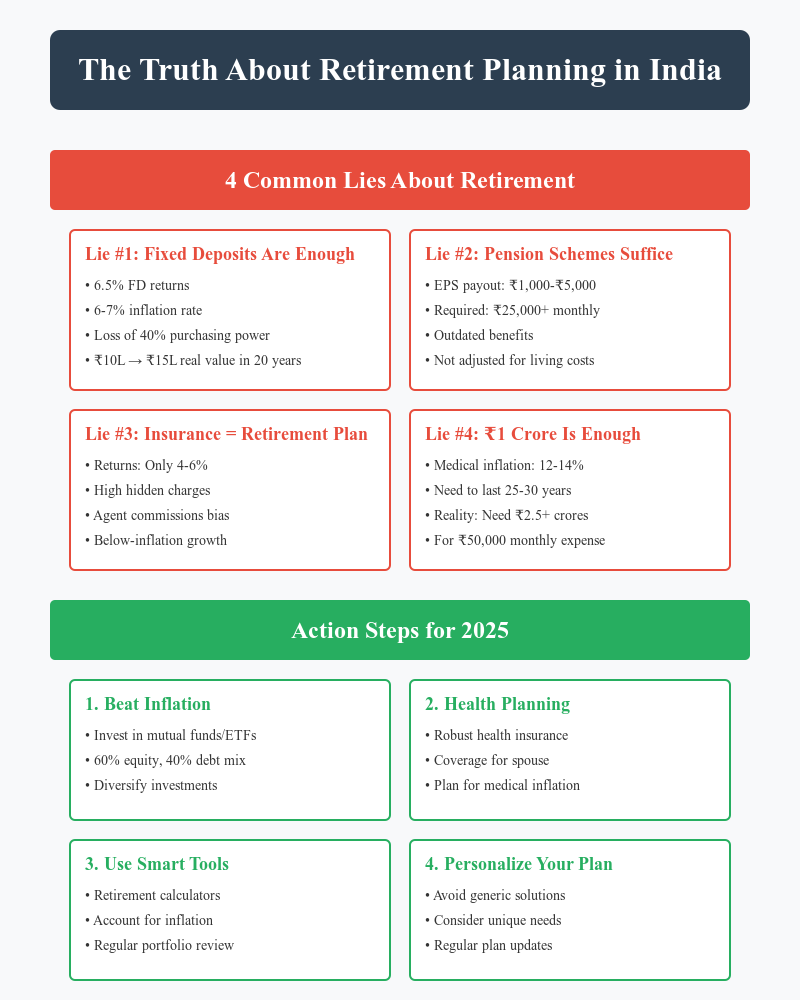Table of Contents
Retirement planning in India is a ticking time bomb, and most people don’t even realize it. Financial institutions, advisors, and even age-old investment products have been systematically misleading millions of Indians. The result? Countless retirees running out of money within years of leaving their jobs, trapped in a cycle of dependency or forced to compromise their dignity.
If you think your current retirement plan is safe, think again. The system is designed to exploit your lack of financial literacy, your trust, and, worst of all, your future. Let’s expose the lies and uncover the brutal reality of retirement planning in India—and what you can do to escape this trap.
Lie #1: Fixed Deposits and PPF Will Secure Your Future
For decades, Indians have relied on Fixed Deposits (FDs) and Public Provident Fund (PPF) as the cornerstones of their retirement savings. Banks and advisors glorify these products as “safe and reliable,” but here’s the truth:
- Inflation Reality Check: With inflation hovering around 6-7% annually, the effective returns on these investments barely keep up. Over 20 years, your “safe” savings in an FD could lose up to 40% of its purchasing power.
- Why It’s a Scam: Financial institutions profit from your deposits by lending at higher rates, while you’re stuck with subpar returns.
Example: ₹10 lakhs invested in an FD today at 6.5% will grow to ₹35 lakhs in 20 years. But factoring in inflation, its real value will be closer to ₹15 lakhs.
Lie #2: Pension Schemes Are Sufficient
The Employee Pension Scheme (EPS) or government pensions were once dependable sources of retirement income. However, they are no longer the safety nets they used to be.
- Shrinking Benefits: EPS payouts are capped at laughably low amounts, often insufficient to cover even basic monthly expenses.
- The Hidden Agenda: These schemes haven’t been updated to reflect rising costs of living or increasing life expectancy, leaving retirees shortchanged.
Lie #3: Insurance Policies Are Retirement Plans
Insurance agents aggressively market endowment and ULIP policies as “perfect retirement solutions.” Here’s the ugly truth:
- Low Returns: These products often deliver annualized returns of just 4-6%, lower than inflation.
- High Costs: Hidden charges eat into your returns, leaving you with a fraction of what you could have earned through direct investments.
- Conflict of Interest: Agents push these products because they earn fat commissions—not because they’re good for you.
Lie #4: The Retirement Corpus You’re Targeting Is Enough
One of the biggest myths sold to Indians is that a ₹1 crore retirement fund is “more than enough.” This outdated figure is a dangerous oversimplification.
- Healthcare Costs: Medical inflation in India is as high as 12-14% annually. A single hospitalization could wipe out lakhs from your savings.
- Longevity Risk: With people living longer, your corpus needs to last 25-30 years, not 10-15 years as most plans assume.
- Lifestyle Inflation: Post-retirement expenses like travel, gifts, and hobbies often exceed pre-retirement levels.
How the Financial Industry Keeps You in the Dark
The retirement planning ecosystem thrives on your lack of knowledge. Here’s how they manipulate you:
- Opaque Products: Complex terms and conditions make it nearly impossible for the average investor to understand what they’re buying.
- Fear-Mongering Tactics: Advisors often scare you into buying products you don’t need, claiming “time is running out.”
- No Accountability: Most financial agents disappear after selling you a product, leaving you to fend for yourself.
The Urgency of 2025: Why You Must Act Now
India’s financial landscape is shifting rapidly, and waiting to “figure it out later” could be disastrous. Here’s why:
1. Tax Changes
New tax rules may erode returns on traditional savings instruments, further shrinking your retirement corpus.
2. Market Volatility
Global uncertainties and economic shifts are creating unpredictable market conditions, making traditional strategies obsolete.
3. Cost of Delay
Every year you delay optimizing your retirement plan, you lose compounding benefits that could add lakhs to your corpus.
What You Must Do to Protect Your Future
1. Switch to Inflation-Beating Investments
Move away from fixed-income products and embrace instruments like mutual funds, ETFs, and direct equity.
Pro Tip: A diversified portfolio with 60% equity and 40% debt is ideal for those in their 30s and 40s.
2. Plan for Healthcare Expenses
Invest in a robust health insurance plan with adequate coverage for you and your spouse.
3. Use Retirement Calculators Wisely
Online tools can help you estimate how much you really need based on your lifestyle, goals, and inflation.
4. Avoid One-Size-Fits-All Solutions
Tailor your plan to your unique needs rather than relying on generic advice from banks or agents.
The Road Ahead: Redefining Retirement Planning in India
The truth is harsh, but it’s also empowering. By acknowledging the flaws in the current system, you can take control of your financial future.
Takeaway: Retirement planning in 2025 requires urgency, adaptability, and a willingness to challenge conventional wisdom.
Don’t be fooled—act now.
This article uncovers the lies, exposes the scams, and provides actionable steps to secure your retirement. Will you take charge, or will you let the system dictate your future? The choice is yours.
Common Questions
What is the biggest mistake Indians make in retirement planning?
The biggest mistake is relying solely on traditional instruments like FDs and PPFs, which often fail to beat inflation and provide inadequate returns for long-term goals.
Are pension schemes no longer effective?
While they offer some support, pension schemes like EPS are insufficient for maintaining a comfortable lifestyle due to capped benefits and inflationary pressures.
How much should I save for retirement?
A general rule is to target a retirement corpus that is 20-25 times your annual expenses. Factor in inflation, healthcare costs, and increasing life expectancy.
Can mutual funds and equities really help with retirement?
Yes, diversified investments in mutual funds and equities provide inflation-beating returns over the long term, making them essential for building a robust retirement corpus.
Why is 2025 critical for retirement planning in India?
The changing financial landscape, including tax reforms, market volatility, and rising costs, makes it crucial to adapt your strategies now to avoid future pitfalls.
A Quick Recap

You Might Also Be Interested in: Women Investors: Why 2025 Is the Year You Can’t Afford to Miss



